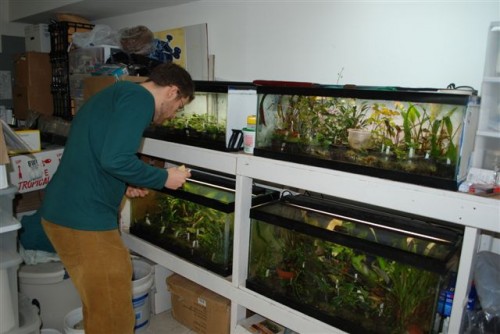March 2011 Meeting
The March, 2011 GWAPA meeting was held at the Merrifield Nursery Center, and Cavan Allen gave a talk about growing aquatic plants emersed.
There are several reasons why aquatic plant enthusiasts might want to grow aquatic plants emersed:
- Aquatic plants will generally grow faster emersed than submersed, so you can grow out larger quantities of plants faster
- If you are unsure of the identity of a plant, you are more likely to get it to flower if it is grown emersed (flowers make identification easier)
- You can grow aquatic plants without algae (you can also rid plants of algae by moving them to an emersed setup)
- You can use your emersed setup as a “holding area” for aquatic plants you don’t currently have a use for in your aquascape (or to store pond plants over winter)
To grow aquatic plants emersed, you only need a few things: A container that can hold a reservoir of water and maintain an elevated humidity, light, and an approach for fertilization. The simplest and cheapest containers could be plastic deli containers – it doesn’t have to be pretty! Pretty much anything that will hold water, let in light, and retain humidity can be used – even brandy snifters with plastic wrap on top! Other approaches include gardening flats with humidity domes, like these:



Kris Weinhold has used ZooMed terrariums as well, as detailed on his blog:
http://www.guitarfish.org/2009/08/06/new-emersed-setup
Another common approach involves using aquariums of various sizes, with tight-fitting glass tops. Ghazanfar, for example, has several 30- and 40-gallon breeders:

Depending on the type of container you’re using, you may want to circulate the water using a small powerhead. While not strictly necessary, water circulation can inhibit growth of mold and/or algae, and generally keep the water from getting “icky”. Having a deep (3-4″) water reservoir (as is common in the aquarium container approach) also allows you to use an aquarium heater to raise the temperature (if, for example, your setups are in your basement).
While you want to maintain a high humidity level, try not to run it too high (e.g., >80%). If you have condensation on the inside of your container, the humidity is probably too high. High humidity without air circulation runs the risk of encouraging mold and mildew, which can smother your plants if left unchecked (and is unsightly). Also, many aquatic plants will grow the submersed forms of their leaves if humidity is too high (Hygrophila difformis is a good example).
To get your plants to convert from their submersed form to their emersed form, you can put them in a ziplock bag or deli container to give it the required high humidity during transition. Many stem plants can be started simply by laying them in water until they start to throw roots off at their nodes.
It is a good idea to put different species of plants in different pots (and label them accurately), and square pots are the most space efficient. To allow the water reservoir to fully wet the substrate, be sure to use draining pots. To keep the substrate from dropping through the drainage holes, a paper towel or coffee filter can be used to line the pot before adding your substrate.
What substrate you choose will depend on your budget, what is easily available, and (to a lesser extent) what kind of plants you’re keeping. In general, aquatic plants are not fussy about substrates, so unless you’re working with so-called “blackwater Crypts”, you can probably use just about anything: sphagnum moss, sand, LECA, turface, standard potting soil, or any of the numerous aquarium substrates.
For lighting, the most common approach is to use T-12 shop lights, as they are inexpensive, moderately efficient, and do not generate too much heat. T5 (and T5HO) fluorescents are more efficient, but put out more heat. Use a 10-12 hour photoperiod, and while you can often get by with a single shop light if you are keeping Crypts, for most plants, it’s difficult to get too much light over the tank. If you’re using seedling trays with humidity domes, placing them on a well-lighted windowsill, or even outside (depending on ambient temperature, of course) can work really well.
There are numerous approaches to fertilization that can be taken, but two of the more common approaches are to use a foliar spray of one quarter strength Miracle Gro or similar commercial gardening fertilizer, or to treat the water reservoir as you would a planted aquarium, and dose ferts into the reservoir. You can even use the waste water from water changes on your aquarium tanks. Which approach is best for you will depend on the containers you’re using, the plants you’re keeping, and what is easiest for you.